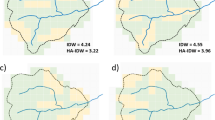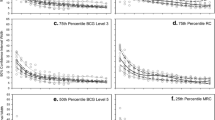Abstract
Identification of reference streams and human disturbance gradients are crucial steps in assessing the effects of human disturbances on stream health. We describe a process for identifying reference stream reaches and assessing disturbance gradients using readily available, geo-referenced stream and human disturbance databases. We demonstrate the utility of this process by applying it to wadeable streams in Michigan, USA, and use it to identify which human disturbances have the greatest impact on streams. Approximately 38% of cold-water and 16% of warm-water streams in Michigan were identified as being in least-disturbed condition. Conversely, approximately 3% of cold-water and 4% of warm-water streams were moderately to severely disturbed by landscape human disturbances. Anthropogenic disturbances that had the greatest impact on moderately to severely disturbed streams were nutrient loading and percent urban land use within network watersheds. Our process for assessing stream health represents a significant advantage over other routinely used methods. It uses inter-confluence stream reaches as an assessment unit, permits the evaluation of stream health across large regions, and yields an overall disturbance index that is a weighted sum of multiple disturbance factors. The robustness of our approach is linked to the scale of disturbances that affect a stream; it will be less robust for identifying less degraded or reference streams with localized human disturbances. With improved availability of high-resolution disturbance datasets, this approach will provide a more complete picture of reference stream reaches and factors contributing to degradation of stream health.
Similar content being viewed by others
References
Allan, J. D. (2004). Landscape and riverscapes: The influence of land use on river ecosystems. Annual Review of Ecology and Systematics, 35, 257–284.
Allan, J. D., Erickson, D. L., & Fay, J. (1997). The influence of catchment land use on stream integrity across multiple spatial scales. Freshwater Biology, 37, 149–161.
Alexander, G. G. (2005). ‘The state of stream restoration in the upper Midwest, USA’, Master’s Thesis, University of Michigan, Ann Arbor, Michigan.
Booth, D. (1991). Urbanization and the natural drainage system – Impacts, solutions and prognoses. Northwest Environmental Journal, 7, 93–118.
Booth, D., & Reinelt, L. (1993). Consequences of urbanization on aquatic systems – Measured effects, degradation thresholds, and corrective strategies. In Proceedings of Watershed 93, A National Conference on Watershed Management (pp. 545–550). March 21–24, 1993, Alexandria, Virginia.
Brenden, T. O., Clark, R. D., Jr., Cooper, A. R., Seelbach, P. W., Wang, L., Aichele, S. S., et al. (2006). A GIS framework for collecting, managing, and analyzing multi-scale variables across large regions for river conservation and management. In R. M. Hughes, L. Wang, & P. W. Seelbach (Eds.), Landscape influences on stream habitats and biological assemblages (pp. 49–74). American Fisheries Society, Symposium 48, Bethesda, Maryland.
Brown, M. T., & Vivas, M. B. (2005). Landscape development intensity index. Environmental Monitoring and Assessment, 101, 289–309.
Cade, B. S., Terrell, J. W., & Schroeder, R. L. (1999). Estimating effects of limiting factors with regression quantiles. Ecology, 80, 311–323.
Crunkilton, R., Kleist, J., Ramcheck, J., DeVita, W., & Villeneueve, D. (1996). Assessment of the response of aquatic organisms to long-term in situ exposures of urban runoff. In L. A. Roesner (Ed.), Effects of watershed development on aquatic ecosystems. Proceedings of an engineering foundation conference. New York, New York: American Society of Civil Engineers.
Dale, V. H., & Beyeler, S. C. (2001). Challenges in the development and use of ecological indicators. Ecological Indicators, 2, 287–293.
Danz, N. P., Regal, R. R., Niemi, J., Brady, V. J., Hollenhorst, T., Johnson, L. B., et al. (2005). Environmental stratified sampling design for the development of Great Lakes environmental indicators. Environmental Monitoring and Assessment, 102, 42–65.
ESRI (2002). PC ARC/GIS Version 8.2. Redlands, California: Environmental System Research Institute.
Fausch, K. D., Lyons, J., Karr, J. R., & Angermeier, P. L. (1990). Fish communities as indicators of environmental degradation. American Fisheries Society Symposium, 8, 123–144.
Galli, J. (1991). Thermal impacts associated with urbanization and storm water management best management practices (p. 188). Washington, District of Columbia: Metropolitan Washington Council of Governments. Maryland Department of Environment.
Harding, J. S., Benfield, E. F., Bolstad, P. V., Helfman, G. S., & Jones, E. B. D. (1998). Stream biodiversity: The ghost of land use past. Proceedings of National Science USA, 95, 14843–14847.
Hughes, R. M. (1995). Defining acceptable biological status by comparing with reference conditions. In W. S. Davis & T. P. Simon (Eds.), Biological assessment and criteria: tools for water resource planning and decision making (pp. 31–48). Boca Raton, Florida: Lewis Publishers.
Hughes, R. M., Larsen, D. P., & Omernik, J. M. (1986). Regional reference sites: a method for assessing stream potential. Environmental Management, 10, 629–635.
Hughes, R., Wang, L., & Seelbach, P. W. (2006). Landscape influences on stream habitats and biological communities. American Fisheries Society Symposium 48, Bethesda, Maryland.
Jones, R. C., & Clark, C. C. (1987). Impact of watershed urbanization on stream insect communities. Water Resources Bulletin, 23, 1047–1055.
Karr, J. R., & Chu, E. W. (1999). Restoring life in running waters, better biological monitoring. Covelo, California: Island Press.
Klein, R. D. (1979). Urbanization and stream quality impairment. Water Resources Bulletin, 15, 948–963.
Koel, C. J., & Stevenson, K. E. (2002). Effects of dredged material placement on benthic macroinvertebrates of the Illinois River. Hydrobiologia, 474, 229–238.
Laessig, R. E., & Duckett, E. J. (1979). Canonical correlation analysis: potential for environmental health planning. AJPH, 69, 353–359.
Lyons, J. (1992). Using the index of biotic integrity (IBI) to measure environmental quality in warmwater streams of Wisconsin. US Forest Service, St. Paul, Minnesota, General Technical Report NC-149.
Lyons, J., Wang, L., & Simonson, T. D. (1996). Development and validation of an index of biotic integrity for cold-water streams in Wisconsin. North American Journal of Fisheries Management, 16, 241–256.
McDonnell, M. J., & Pickett, S. T. A. (1990). Ecosystem structure and function along urban–rural gradients: An unexploited opportunity for ecology. Ecology, 71, 1232–1237.
Moscrip, A. L., & Montgomery, D. R. (1997). Urbanization, flood frequency, and salmon abundance in Puget Lowland streams. Journal of the American Water Resources Association, 33, 1289–1297.
Norris, R. H., & Hawkins, C. P. (2000). Monitoring river health. Hydrobilogia, 435, 5–17.
Omernik, J. M. (2003). The misuse of hydrologic unit maps for extrapolation, reporting, and ecosystem management. Journal of the American Water Resources Association, 39, 563–573.
Paul, M. J., & Meyer, L. (2001). Streams in the urban landscape. Annual Review of Ecology and Systematics, 32, 333–365.
Roth, N. E., Allan, J. D., & Erickson, D. L. (1996). Landscape influences on stream biotic integrity assessed at multiple spatial scales. Landscape Ecology, 11, 141–156.
SAS Institute (2004). SAS/STAT online user’s guide, version 9.1. Cary, North Carolina: SAS Institute.
Schlosser, I. J. (1982). Trophic structure, reproductive success, and growth rate of fishes in a natural and modified headwater stream. Canadian Journal of Fisheries and Aquatic Sciences, 39, 968–978.
Seelbach, P. W., & Wiley, M, J. (1997). Overview of the Michigan rivers inventory project. Michigan Department of Natural Resources, Fish Division Technical Report 97-3, Ann Arbor, Michigan.
Seelbach, P. W., Wiley, M. J., Baker, M. E., & Wehrly, K. E. (2006). Initial classification of river valley segments across Michigan’s lower Peninsula. In R. M. Hughes, L. Wang, & P. W. Seelbach (Eds.), Landscape influences on stream habitats and biological assemblages (pp. 25–48). American Fisheries Society, Symposium 48, Bethesda, Maryland.
Smith, R. A., Schwarz, G. E., & Alexander, R. B. (1997). Regional interpretation of water-quality monitoring data. Water Resources Research, 33, 2781–2798.
Suter, G. W. II., Norton, S. B., & Cormier, S. M. (2002). A methodology for inferring the causes of observed impairments in aquatic ecosystems. Environmental Toxicology and Chemistry, 21, 1101–1111.
USEPA (United States Environmental Protection Agency) (1996). Biological criteria: Technical guidance for streams and small rivers. EPA/822/B-96/00, Washington, District of Columbia.
USEPA (US Environmental Protection Agency) (2000) Stressor identification guidance document. EPA-822-B-00-025, Washington, District of Columbia.
USEPA (US Environmental Protection Agency) (2005). Use of biological information to better define designated aquatic life uses in state and tribal water quality standards: Tiered aquatic life uses. EPA-822-R-05-001, Washington, District of Columbia.
Wang, L., & Lyons, J. (2003). Fish and benthic macroinvertebrate assemblages as indicators of stream degradation in urbanizing watersheds. In T. P. Simon (Ed.), Biological response signatures: Multimetric index patterns for assessment of freshwater aquatic assemblages (pp. 227–250). Boca Raton, Florida: CRC Press.
Wang, L., Lyons, J., & Kanehl, P. (2002). Effects of watershed best management practices on habitat and fish in Wisconsin streams. Journal of the American Water Resources Association, 38, 663–680.
Wang, L., Lyons, J., & Kanehl, P. (2003). Impacts of urban land cover on trout streams in Wisconsin and Minnesota. Transactions of the American Fisheries Society, 132, 825–839.
Wang, L., Lyons, J., Kanehl, P., Bannerman, R., & Emmons, E. (2000). Watershed urbanization and changes in fish communities in southeastern Wisconsin streams. Journal of the American Water Resources Association, 36, 1173–1189.
Wang, L., Lyons, J., Kanehl, P., & Gatti, R. (1997). Influences of watershed land use on habitat quality and biotic integrity in Wisconsin streams. Fisheries, 22(6), 6–12.
Wang, L., Lyons, J., Rasmussen, P., Kanehl, P., Seelbach, P., Simon, T., et al. (2003). Influences of landscape- and reach-scale habitat on stream fish communities in the Northern Lakes and Forest ecoregion. Canadian Journal of Fisheries and Aquatic Science, 60, 491–505.
Wang, L., Seelbach, P. W., & Hughes R. (2006a). Introduction to landscape influences on stream habitats and biological assemblages. In R. M. Hughes, L. Wang, & P. W. Seelbach (Eds.), Landscape influences on stream habitats and biological assemblages (pp. 1–23). American Fisheries Society, Symposium 48, Bethesda, Maryland.
Wang, L., Seelbach, P. W., & Lyons, J. (2006b). Effects of levels of human disturbance on the influence of catchment, riparian, and reach scale factors on fish assemblages. In R. M. Hughes, L. Wang, & P. W. Seelbach (Eds.), Landscape influences on stream habitats and biological assemblages (pp. 199–219). American Fisheries Society, Symposium 48, Bethesda, Maryland.
Weaver, L. A., & Garman, G. C. (1994). Urbanization of a watershed and historical changes in a stream fish assemblage. Transaction of the American Fisheries Society, 123, 162–172.
Wernick, B. G., Cook, K. E., & Schreier, H. (1998). Land use and streamwater nitrate-N dynamics in an urban–rural fringe watershed. Journal of the American Water Resources Association, 34, 639–650.
Whittier, T. R., Stoddard, J. L., Hughes, R. M., & Lomnicky, G. (2006). Associations among catchment- and site-scale disturbance indicators and biological assemblages at least- and most-disturbed stream and river sites in the Western USA. In R. M. Hughes, L. Wang, & P. W. Seelbach (Eds.), Landscape influences on stream habitats and biological assemblages (pp. 641–664). American Fisheries Society, Symposium 48, Bethesda, Maryland.
Wichert, G. A. (1995). Effects of improved sewage effluent management and urbanization on fish associations of Toronto streams. North American Journal of Fisheries Management, 15, 440–456.
Wilhelm, J. G. O., Allan, J. D., Wessell, K. J., Merritt, R. W., & Cummins, K. W. (2005). Habitat assessment of non-wadeable rivers in Michigan. Environmental Management, 35, 1–19.
Author information
Authors and Affiliations
Corresponding author
Additional information
An erratum to this article can be found at http://dx.doi.org/10.1007/s10661-008-0397-0
Rights and permissions
About this article
Cite this article
Wang, L., Brenden, T., Seelbach, P. et al. Landscape Based Identification of Human Disturbance Gradients and Reference Conditions for Michigan Streams. Environ Monit Assess 141, 1–17 (2008). https://doi.org/10.1007/s10661-006-9510-4
Received:
Accepted:
Published:
Issue Date:
DOI: https://doi.org/10.1007/s10661-006-9510-4




